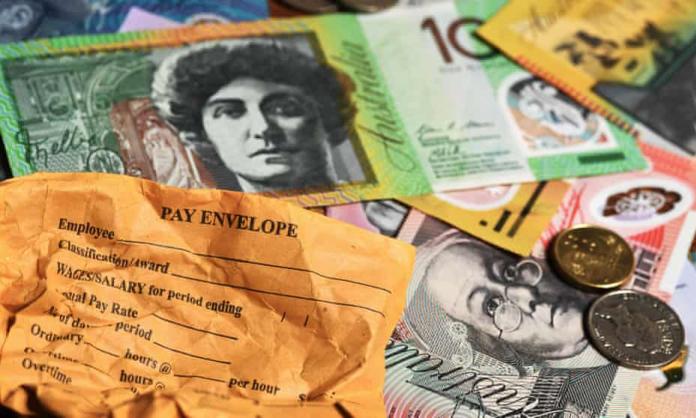The federal budget includes measures that the government says will ease the “cost of living squeeze”, but which will do nothing to offset years of stagnant wages. In response, the ALP is offering next to nothing and the unions are refusing to fight.
In a last-ditch attempt to save his skin, Morrison is handing out billions to private schools, small business owners, the construction industry, the military and the national security agencies. The budget also includes $250 cash payments for pensioners, carers, veterans, the unemployed and concession card holders, an extension of tax relief for low- and middle-income earners and a cut in the fuel excise.
But unlike the looming tax cuts for the wealthiest people in the country, which will be permanent and worth thousands of dollars per year for individuals, all the budget sweeteners for regular working-class people are strictly temporary, or one-off payments that will provide relief for at best a month or two. Even the extension in the tax offset for low- and middle- income earners is set to end next year, cutting annual take-home pay by up to $1,500 unless the new government takes action.
Many have been left out altogether. People with Disability Australia called it a “lean, mean budget for people with disabilities”. Not-for-profit age care providers have pointed out the inadequacy of the response to the Age Care Royal Commission. In the context of an ongoing pandemic that has shown the inadequacies of the healthcare system, the government refuses to spend the money needed to address the problems.
With property prices through the roof and rental properties unaffordable for lower-income earners in so many suburbs, the prime minister told renters that they should just try to buy a house. But the government’s first home buyers’ scheme and its tax breaks for property investors, which jack up house prices, only make that prospect even more ludicrously distant for many, if not most, young people.
The ALP has correctly attacked the budget for doing nothing to help workers who have endured years of flat or falling real wages. Shadow Treasurer Jim Chalmers told ABC Radio National the day after the budget that “the average family is $3,600 worse off over the past year”. The budget papers predict 4.25 percent inflation in 2021-22 and a 2.75 percent increase in average wages—so we’re looking at a 1.5 percent deterioration in purchasing power.
Next year the forecast is for a slight 0.25 percent increase in wages after inflation and a 0.5 percent lift in 2023-24. But existing enterprise agreements, which cover one-third of the workforce, on average deliver annual wage rises of 2.6 percent, well below the current rate of inflation.
Awards cover another quarter of the workforce, disproportionately the low-paid and women, and here the future is no better. In June, the Fair Work Commission is due to hand down its decision to vary the minimum wage, now standing at a pitiful $20.33 an hour, less than one half of median earnings. The Commission is unlikely to offer much of an advance on the 2.5 percent rise last year, which we now know has resulted in a real pay cut. So unless something is done, more wage cuts are guaranteed.
That workers face continued pressure on this front is an indictment not just of the Morrison government and the employers, but of the ALP and the trade unions.
There could not be a better political opportunity to lift wages. As the government’s own budget rhetoric acknowledges, the wages squeeze has become an issue of widespread concern. Everyone from the Australian Council of Social Service (ACOSS) to the Business Council of Australia and the Reserve Banks says that wages must rise. There is ample political space for the ALP to act on this front, to its electoral advantage.
In his budget reply, Labor leader Anthony Albanese said that his party has a “plan to increase wages”. But the policies on offer do not at all amount to some great plan. Labor says it will fund any increase to the pay of aged care workers awarded by a Fair Work Commission review and will support an increase in the pay of childcare workers. It says that it will reform the industrial relations system to ensure “same job, same pay”—in theory stopping companies using labour hire companies to cut wages and conditions.
It says that it will declare wage theft a crime, although given the dire shortage of wages inspectors and low union coverage in the worst affected sectors, that is unlikely to have much of an effect. It will make it easier for casual workers to convert to permanent status, although this will do nothing immediately to lift wages.
But Labor obstinately refuses to directly lift wages where it could do so. If it had the numbers in the Senate, an incoming Labor government could legislate an increase the minimum wage applying across all awards. Short of that, it could at least support the ACTU’s submission to the Fair Work Commission to lift the minimum wage by 5 percent (only just above inflation!). But Chalmers says that isn’t the government’s job—it’s up to the Fair Work Commission, which is stuffed full of pro-boss appointees, to decide.
Labor governments could lift the wages cap for state and federal public sector workers. But instead, state Labor governments have been some of the worst offenders, setting caps below inflation or freezing wages. The Andrews government in Victoria, for example, has imposed a wages cap for 2022 of just 1.5 percent.
Labor could also reverse the cuts to penalty rates introduced by the Coalition government in 2015, which hit the wages of hundreds of thousands of some of the lowest paid workers. But it has said nothing about this.
Labor is also offering nothing to those dependent on welfare. As with wages, there is widespread acknowledgement that the government should increase allowances for the unemployed, those caring for children or family members, those with disabilities and the elderly. ACOSS is calling for JobSeeker and Youth Allowance to be lifted by $177 per week, to the level of the age pension. Yet Labor will only “review” JobSeeker and has made no commitment to raise Rent Assistance, which is essential for so many welfare recipients.
Labor could put more money in workers’ pockets by undoing all the regressive changes to taxation in the past decade. It could make business and the rich pay more tax and reduce marginal rates for everyone on less than median wages. It could cut the GST, which disproportionately hits the poor, and lift Family Tax Benefits for low-income families.
A Labor government could also make it easier for workers to fight for higher wages by reducing the legal restrictions on the right to organise and strike. But it is making no such commitments.
Labor refuses to campaign for the working class because it is so keen to win the support of the bosses and the mainstream media. Its only “plan” to increase wages outside a few sectors is “trickle down”—workers and unions working together with the bosses to lift productivity, purportedly to create “secure jobs”. Workers’ wages will be entirely dependent on the contribution they can make to raising profits for the capitalists.
Labor leaders take for granted that most workers will vote for the party because they are sick of the Coalition. They can do this in part because the unions are putting no pressure on them.
Just as there is plenty of political space for Labor to move, so the unions are now in a strong bargaining position. Unemployment is at a 50-year low. Bosses in a wide range of industries are complaining of labour shortages, that they “can’t get staff”, and that public health measures have limited their ability to access a pool of highly exploitable short-term visa workers.
But unions have been asleep, refusing to use their industrial muscle to push up wages. Strikes are at an all-time low. The current industrial campaigns by NSW nurses, midwives and railway workers have the potential to deliver wage justice, but there is very little action like this—most unions put up a half-hearted show of resistance to wage cuts and freezes and then surrender.
“There are practical things this government can do to lift wages, but so far they have sat on their hands or pretended it’s someone else’s job”, says ACTU Secretary Sally McManus. That charge could just as easily be levelled at the union leaders, who for years have done nothing to lead a fight for higher wages.
The unions are most active at election time when campaigning for Labor governments. But they make no real demands that Labor must reward workers in return for this support and, by turning out organisers and union delegates in their thousands to work the polling booths and call centres, they turn the unions into machines to simply get the vote out for Labor.
Albanese says that Labor’s plan is “not radical”, it’s “renewal not revolution”. In other words, for workers and those on welfare, it’s just the same old, same old. Years of wage stagnation beckon unless our side begins to fight. But that means breaking with the pro-boss politics that dominates the ALP and the passivity of the trade union leaders.









